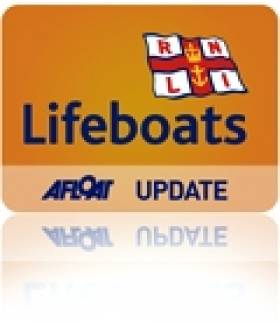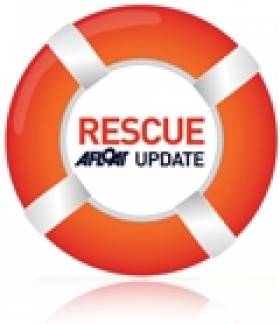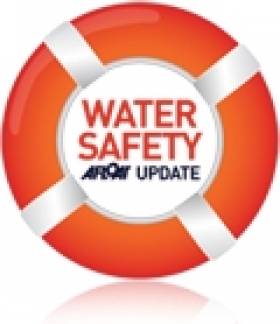Displaying items by tag: swimming
Teenager Dies In River Shannon Swimming Incident
#Shannon - A teenage boy has died after getting into difficulty while swimming in the River Shannon in Athlone yesterday (Wednesday 10 June), as RTÉ News reports.
The 14-year-old was recovered from the water near the Athlone Sub Aqua Club after a short search by club members and Coosan Point lifeboat volunteers.
But he later died in hospital after being transferred from Portincula to Temple Street.
RTÉ News has more on the story HERE.
#OnTheWater - This week's unseasonably fine weather saw thousands flock outside to enjoy the sunshine - and many of them headed to Ireland's finest beaches, some of which were highlighted by JOE.ie.
Among the most beautiful stretches of sand selected by the website include Brittas Bay – a perennial favourite in Dublin and Wicklow alike – as well as Inchydoney in West Cork, surfers' choice Tullan Strand in Bundoran, and the sheltered calm of Keem Beach on Achill Island.
All are recommended for their relaxing potential and arresting views as much as for swimming.
But one place where swimming is definitely not recommended is at Dublin's Docklands, where young people were seen leaping from a quayside roof into the River Liffey yesterday (Friday 10 April).
TheJournal.ie has an image of the group jumping from the roof of a restaurant on North Wall Quay just west of the Samuel Beckett Bridge, flying over the heads of unsuspecting passers-by on the footpath below.
The Irish Coast Guard has reiterated previous warnings "not to engage in this particular type of activity" which amounts to "literally jumping into the unknown".
#FortyFoot - It's grim news for the Forty Foot's swimming club as members agreed this week to put its future up to vote.
The Irish Times reports on Thursday night's (27 November) extraordinary general meeting held in the wake of the Sandycove Bathers' Association's loss of insurance cover.
That came after a €7,000 settlement over a claim made against the club and Dun Laoghaire-Rathdown County Council by a member of the public, as covered previously on Afloat.ie.
The claim clouded a situation already made bleak by a substantial insurance payout in 2004 to a non-club-member who suffered serious injuries while diving at the Dublin Bay swimming hole made famous in James Joyce's Ulysses.
And the potential future exposure of the club's members to litigation has prompted a vote on disbanding and dropping their lease on the Forty Foot when they reconvene in two weeks' time.
The Irish Times has more on the story HERE.
Forty Foot Bathing Club's Future Up For Vote At EGM
#FortyFoot - The Sandycove Bathers' Association will hold an EGM this Thursday 27 November on its future at the famous Forty Foot after its insurer withdrew cover.
According to The Irish Times this morning, the club announced in a letter to members that its insurer Allianz has withdrawn public liability cover in the wake of a €7,000 settlement after a claim against it and Dun Laoghaire-Rathdown County Council (DLRCoCo).
As a result, the club will now vote on whether it should continue to manage and maintain the popular Dublin Bay swimming spot, which features prominently in James Joyce's Ulysses, and was in the news earlier this year after the club lifted its long-time ban on women members.
If the club does pull out, DLRCoCo says it would take over the Forty Foot and. among other things, open it to public bathing.
The Irish Times has more on the story HERE.
Wicklow Lifeboat Rescues Swimmer Off Brides Head
#RNLI - Wicklow RNLI rescued a male swimmer who got into difficulty yesterday afternoon (Thursday 4 September).
The rescue followed a request from the Irish Coast Guard for the volunteer lifeboat crew to search for a missing swimmer at Silver Strand beach.
The alarm was raised by the swimmer’s wife who was concerned for his safety and by members of the public who heard his call for help.
The all-weather lifeboat had already launched at 2.30pm and was on her way to meet and escort a former visiting lifeboat into the harbour when it was requested.
The lifeboat diverted immediately and proceeded south towards Wicklow Head to begin a search. The inshore lifeboat also launched to assist. Weather conditions and visibility in the area were good at the time.
During the search, a person was spotted in the water about one mile offshore near Brides head.
The all-weather lifeboat, under the command of second coxswain Ciaran Doyle, was quickly alongside the casualty. Crewmember Matt Doyle took him from the water using a scramble net.
First aid was administered to the exhausted man by Carol Flahive as the lifeboat made its way back to Wicklow Harbour.
The lifeboat was met on arrival at the East Pier by a waiting ambulance, where the swimmer was treated by paramedics. He did not need to be hospitalised.
It was quickly established that the man had been swimming off Silver Strand when he was carried quite a distance north with the tide and strong currents, which prevented him getting ashore.
At Wicklow Head, he was swept further out to sea. That's when members of the public on the cliff contacted the coastguard after hearing his call for help.
Speaking after the callout, Wicklow RNLI lifeboat operations manager Des Davitt said: "The swimmer was extremely lucky today to be spotted so quickly by the crew and thankfully a tragic outcome was avoided."
Killiney's Blue Flag Lowered Again Over High E.Coli Readings
#DublinBay - Killiney Beach has had its Blue Flag lowered for the second time in four weeks after tests on Monday 11 August showed high levels of E.Coli and Enterococci in the water.
Dun Laoghaire-Rathdown County Council, which has also posted a no-swimming advisory at Sandycove Harbour for high levels of the latter contaminant, expects to learn the results of its latest water samples this Friday 15 August.
But for the meantime, Killiney's Blue Flag is removed pending the council's investigations into the cause of the high bacteria readings, which is not yet known.
Last month Killiney and White Rock in Dalkey were closed to swimming due to unsafe levels of bacteria in the coastal waters of south Dublin Bay.
It's the latest in a string of bad news for Dublin's beaches, following last week's bathing prohibition at 12 beaches in the north of the county, and the arrival of dangerous stinging sea creatures such as the Portuguese man o'war and the lions mane jellyfish.
North Dublin Beaches Nix Bathing After Pump Station Overflow
#CoastalNotes - After last month's temporary bathing bans for a number of Dublin Bay beaches and swimming spots comes news that 12 beaches in North Co Dublin - a number of which were awarded Blue Flags earlier this summer – are at present not safe for swimming.
As TheJournal.ie reports, the advisory from Fingal County Council relates to pump station overflow caused by the weekend's heavy rains, which has affected the water quality off Balbriggan and Hampton Cove, Loughshinny, Skerries north and south, Balcarrick, The Brook and Tower Bay at Portrane, Velvet Strand at Portmarnock, the Burrow at Sutton and Claremont near Howth.
The advisory will remain in place till the end of this week as council officials collect fresh samples of the coastal waters.
Lifeguards Rescued 413 Swimmers Last Month
#watersafety – The CEO of Irish Water Safety, John leech is urging the public to use the Local Authority manned lifeguarded bathing places to ensure there are no more swimming tragedies this summer.
Please take heed of advice given by the lifeguards and supervise your children, as lifeguards are not baby sitters.
Lifeguards rescued 413 casualties from our beaches, rivers and lakes during the month of July, that is 146 less than for last July during that memorable heat wave.
There were 353 lost children reunited with their parents.
There were another 8,442 accidents prevented by the proactive actions of our lifeguards.
The CEO is also warning the public that due to the high temperatures in our waters, the prevailing westerly winds and Atlantic current, potentially dangerous jellyfish are appearing on our beaches.
Portuguese man o 'war jelly fish have been reported on Bunmahon and Clonea strand in Waterford, whilst barrel jellyfish have been reported on beaches in Cork.
|
|||||||||||||||||||||||||||||||||||||||||||||||||||||||||||||||||||||||||||||||||||||||||||||||||||||||||||||||||||||||||||||||||||||||||||||||||||||||||||||||||||||||||||||||||||||||
#watersafety - August is the most popular month for outdoor swimming, prompting Irish Water Safety's appeal to swim at Lifeguarded waterways and to stay close to shore and within your depth.
Ireland averages 135 drownings every year. Drownings happen quickly and silently yet people can stay safe by heeding the following advice:
Safe Swimming in August:
1. Swim at lifeguarded waterways - all listed at www.iws.ie.
2. Swim within your depth and stay within your depth.
3. Swim parallel and close to shore.
4. Swim with others in bathing areas that are traditionally recognised as safe.
5. Never use inflatable toys in open water or swim out after anything drifting.
6. Pay attention to signs on the beach and supervise children at all times.
7. Never swim in the dark, late at night or after consuming alcohol.
8. Avoid staying in the water too long.
9. In Marine Emergencies, call 112 and ask for the coastguard.
No matter what your aquatic activity, when you are on or near water always wear a correctly fitted lifejacket with a crotch strap.
Children are curious about water therefore it is critical that adults supervise children at all times.
'By Land, Sea & Air': The Day Women Stormed The Forty Foot
#FortyFoot - Just a few months after the swimming club at Dublin Bay's famous Forty Foot bathing spot lifted its ban on women members, The Irish Times looks back on the day 40 years ago when Sandycove was 'invaded' by a group of campaigning women.
Renowned journalist Nell McCafferty was one of those who joined the so-called Dublin City Women's Invasion Force to highlight the sexism of their exclusion from the swimming spot made famous by James Joyce's Ulysses.
“There was loads of sexist abuse from the men in language that was acceptable at the time,” she said.
But the actions of these women was transformative for the Forty Foot, as McCafferty recalls finding an area with men, women and children swimming together when she returned the following year.
The Irish Times has more on the story HERE.







































































